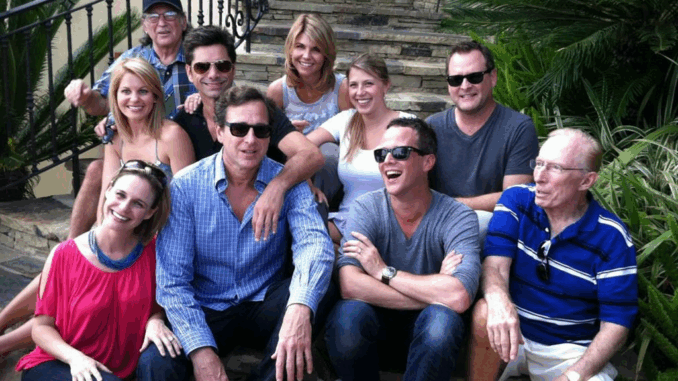
When Full House debuted in 1987, no one expected the quirky sitcom about a widowed father raising his three daughters—with the help of his best friend and brother-in-law—to become a pop culture phenomenon. But it did. More than just a family comedy, Full House helped redefine what a family looked like on TV and delivered life lessons with a laugh track and a hug.
So what made Full House stand out, and why is it still so loved today? Let’s explore how this heartwarming show changed American television and left a legacy that still resonates.
Redefining the American Family
Non-Traditional Families Took Center Stage
At a time when most sitcoms followed the “mom, dad, and kids” formula, Full House flipped the script. Danny Tanner was a single dad raising three girls with his childhood best friend Joey and rock-n-roll brother-in-law Jesse. It wasn’t traditional, but it was real.
Millions of viewers—especially children of divorced or single-parent households—finally saw a version of their own family on screen. Full House told them: your family is valid, even if it doesn’t look like the “TV ideal.”
Every Episode Was a Lesson
Comedy with a Moral Core
Sure, it was funny. But what kept people coming back was the message. Every episode ended with a moral. Whether it was about honesty, dealing with grief, standing up to peer pressure, or learning to say “I’m sorry,” Full House made values cool.
And let’s not forget the signature “emotional music” that cued right before Danny or Uncle Jesse dropped a heartfelt monologue. It was cheesy, but it worked.
The Rise of the Family Sitcom Era
Inspiring a Wave of Family-Friendly Shows
Full House wasn’t alone for long. Its success inspired other ‘TGIF’ hits like Step by Step, Family Matters, and Boy Meets World. Networks realized the value of family-friendly programming that appealed to both kids and parents.
It helped build ABC’s Friday night lineup into a cultural institution. Families didn’t just watch TV—they watched together.
Michelle Tanner: A Cultural Icon
“You got it, dude!” and Other Catchphrases
The character of Michelle Tanner, played by Mary-Kate and Ashley Olsen, became one of the most recognizable child roles in television history. Her catchphrases—“You got it, dude,” “You’re in big trouble, mister,” and “No way, José”—took on a life of their own.
Michelle wasn’t just a character; she became a brand, launching the Olsen twins into superstardom and setting the blueprint for child actors and kid-focused merchandising.
Diversity and Representation: Room for Growth
Where It Fell Short
Despite its groundbreaking approach to family structure, Full House lacked diversity in race, culture, and class. It was a very “white, middle-class” version of America, with little representation of other communities.
Still, it opened the door to family sitcoms that would later embrace more diversity—shows like The Fresh Prince of Bel-Air, Moesha, and Black-ish took the concept of heartfelt family stories and expanded it to include more voices.
A Blueprint for TV Reboots
How ‘Fuller House’ Gave the Franchise New Life
In 2016, Netflix brought the Tanner family back with Fuller House. The sequel series followed D.J. Tanner as a single mother raising her three sons—with help from her sister Stephanie and best friend Kimmy.
It was a clear nod to the original formula, now flipped. The show capitalized on nostalgia while also showing that family values—and challenges—evolve but never go out of style.
A Lasting Legacy in Pop Culture
From Memes to Music
Even today, Full House memes float around the internet, and the theme song “Everywhere You Look” instantly brings a smile to anyone who grew up watching the show.
Pop culture references to Uncle Jesse’s hair, Danny’s obsessive cleaning, or Joey’s silly voices prove that Full House remains embedded in the cultural fabric—even for those who weren’t alive in the ’80s or ’90s.
Why Does It Still Matter?
Because Full House was never just about being funny—it was about being real. It embraced awkward moments, tough conversations, and unconditional love. It reminded viewers that no matter what happens, your family—whether chosen or blood—will be there for you.
That kind of message never goes out of style.
FAQs
1. Why was Full House so popular in the 1990s?
It combined humor with heartfelt lessons, relatable characters, and a focus on family values. It was safe, sincere, and fun for all ages.
2. Was Full House the first show to feature a non-traditional family?
No, but it was one of the most successful and mainstream examples, especially in the late ’80s and early ’90s.
3. Did Full House influence future family sitcoms?
Absolutely. It helped establish the tone and structure for many family shows that followed, especially those targeting both kids and parents.
4. What made Michelle Tanner so iconic?
Her adorable one-liners, played by Mary-Kate and Ashley Olsen, resonated with kids and adults alike. She became the breakout star of the show.
5. Is Full House still worth watching today?
Yes. While dated in some ways, the themes of love, support, and growing up are timeless. It also serves as a nostalgic comfort watch for millions of fans.
